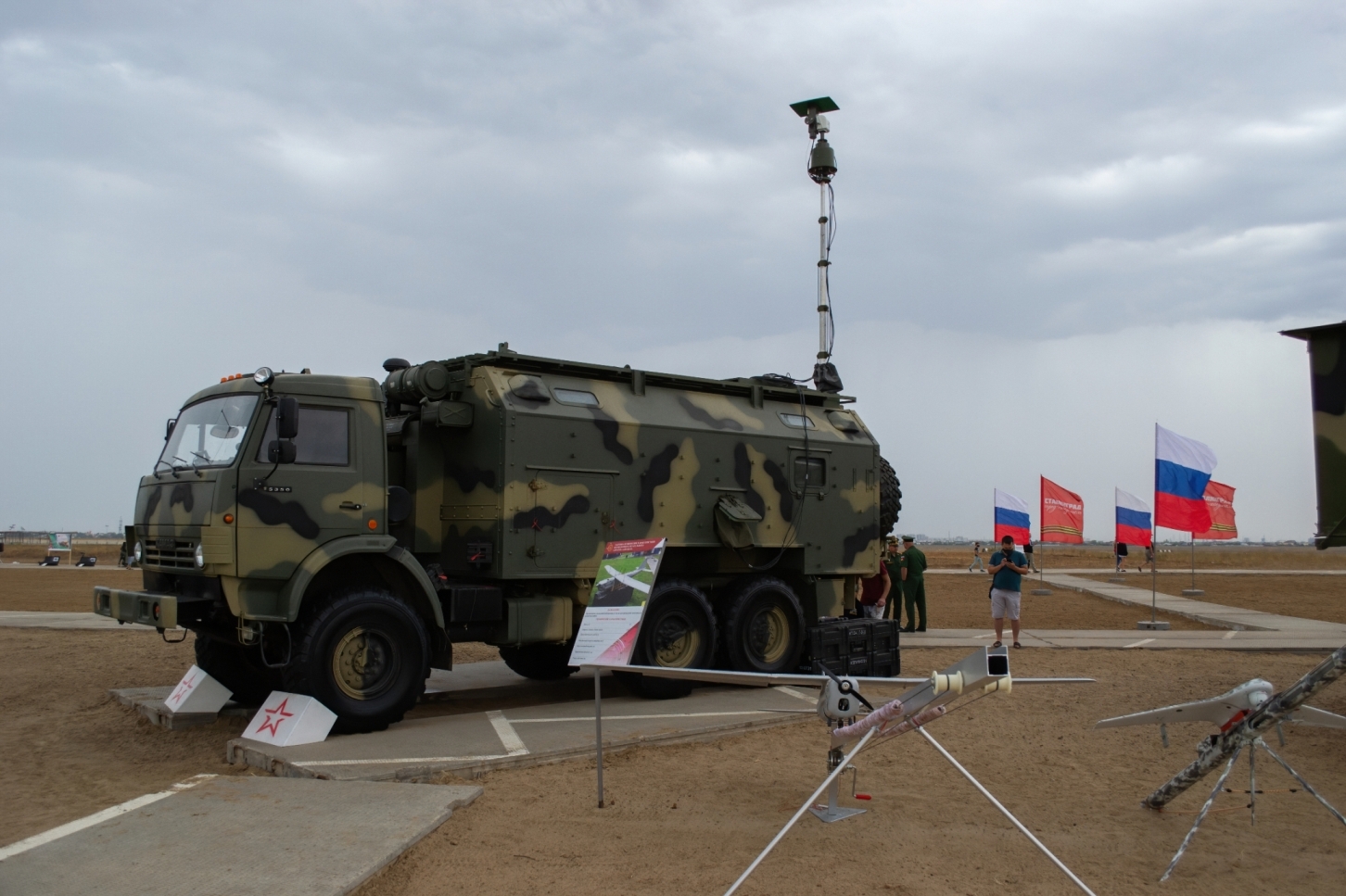Abstract: Ongoing drone attacks have made us aware that unmanned weapon systems have become the means of first choice in modern warfare and simultaneously demonstrate the performance capabilities that such drones have today. Current drone warfare is an evident phenomenon of modern wars. Aside from the legitimate arguments of Western States regarding the ability of a more precise and, thus, potentially more humane way of waging war, it is clear that other actors have also recognized the benefits of using drones. They are a cheap and efficient tool and, if used accordingly, can have a strategic impact.
Bottom-line-up-front: In the future, more flying objects of “unknown” origin will appear in the theaters of war around the world. It is only a matter of time before the first drone controlled by terrorists will target a soccer stadium or critical infrastructure in supposedly safe countries – with criminal intent and devastating effect.
Problem statement: How did the most recent warfare developments shown in the Nagorno-Karabakh conflict affect the future way of war?
So what?: Drones are already weapons-carriers, whether by carrying air-to-ground weapons or being loaded with explosives. However, drones could also be used for the deployment of chemical or biological weapons. If such use were even to occur in swarm form, the consequences might be catastrophic. Governments need to prepare and equip their armed forces in this regard.

Source: Shutterstock.com/Lutsenko_Oleksandr
Since the terrorist attacks of September 11, 2001, in the USA, conflicts, disputes and unrest have increased worldwide. Even extensive Western military interventions have not been able to end this trend. Moreover, a confrontation between great powers, analogous to the Cold War, seems conceivable. In the Near and Middle East, in Africa, the Caucasus, and close to the European Union’s periphery, deadly conflicts prevail, and new dangerous crises continue to arise. While especially the Western World is completely preoccupied with containing the COVID-19 pandemic, newer and deadlier disruptive technological developments are being announced year after year. The attacks by armed drones to kill al-Qaeda leadership cadres, carried out by the U.S. as an immediate response to 9/11, were only the prelude. Ongoing close monitoring of the battlefield since 2001 shows that semi-autonomous systems are now being used as a major tool of warfare in all conflicts. In the areas where current conflicts are being violently fought, a lasting and comprehensive change in warfare is becoming progressively apparent. Unmanned reconnaissance and weapon systems are becoming increasingly important – in some cases already to a decisive extent – in all domains of warfare. Among these developments, the use of drones of various types stands out in particular.[1]
While especially the Western World is completely preoccupied with containing the COVID-19 pandemic, newer and deadlier disruptive technological developments are being announced year after year.
The 44-days’ war between Armenia and Azerbaijan from September to October 2020 portrayed a new reality. War of the future will be fought with the inclusion of drones. In Nagorno-Karabakh a whole range of different drone systems have been employed. Azerbaijan procured an impressive and powerful range of different drone systems in recent years. Azerbaijan was able to count on external support, not only in the procurement of so-called “loitering” drones (colloquially also called “kamikaze drones”) of the type “Harop”, “Orbiter 1K” or “SkyStriker”. Addiontally, a “Medium Altitude High Endurance” (MALE) drone of the type “Hermes 900” from the Israeli company Elbit was procured as a potent armed system, which is comparable in capability to the American MQ-9 “Reaper” or Chinese “Wing Loong” Unmanned Combat Aerial Vehicle (UCAV) systems. However, looking at the videos released by Azerbaijan about their drones’ successes against the armed forces of Artsakh and Armenia, respectively, one can closely examine the use of armed Turkish TB2 “Bayraktar” drones and several “Loitering Unmanned Aerial Vehicle” systems. The MAM-L air-to-surface missiles deployed by the Turkish TB2s, along with the deployed “loitering” drones, were responsible for the devastating losses suffered by Armenia’s armed forces in Nagorno-Karabakh. Moreover, it shows the Turkish TB2’s capabilities, which were also previously demonstrated in Libya, Syria, and in the Kurdish areas. In addition, there is another not less significant factor: due to the small radar cross-section of the attacking drones, the Armenian air defense systems could not detect them. Furthermore, supporting jamming measures in the electromagnetic spectrum (e.g. by Turkish “Koral” systems) ensured the absence of effective air defense. The latter was also localized and neutralized by using slow-flying drones (which enticed the air defenses to emit a detection signal).[2]
Drones were the ideal tool for the war in Karabakh.
In particular, “loitering” drones are cheap, difficult to detect and, at the same time, precise lethal weapon systems. Not requiring a human pilot on board is also advantageous. Armed MALE drones make it possible to reconnoiter a target with precision and engage it with air-to-ground missiles. Here, too, a possible shutdown means no risk of pilot loss. The use of “loitering” drones is also accompanied by a psychological effect that must not be underestimated. In Karabakh, for example, the approach of the “loitering” drones was heralded by unique engine noise that increases to a piercing howl as they dive, followed by the explosion on impact. For the soldiers on the ground, who could also barely see the falling drone, this had enormous demoralizing consequences; only comparable to the missions of the Ju87 “Stuka” of the German Air Force in World War II. The blurred videos of the Armenian soldiers affected and scared to death illustrate this all too clearly.[3]
However, in September 2020, drones played an important role not only in Karabakh. In early September 2020, a spokesman for the Yemeni renegade army faction, supported by the insurgent Houthis, announced in a press conference that they had succeeded in attacking the Saudi airport in Abha with their long-range drones. This report sheds new light on emerging means of conflict that is often neglected by the public. Real drone war is raging in Yemen and Saudi Arabia. While American MALE drones of the type MQ-9 “Reaper” hunt Al-Qaeda fighters on Yemeni territory, Houthi rebels defend themselves against the attacks of a coalition led by Saudi Arabia using drones loaded with explosives, including “loitering” drones. For example, on January 10, 2019, an attack by “Qasef-2K” drones on a parade at the Anad airbase not only killed the head of Yemen’s pro-government military intelligence, Major General Mohammad Saleh Tamah, and another five guests in the VIP stand but also injured 25 soldiers, some of them seriously.[4] A week earlier, on January 3, 2019, a “Reaper” drone in Baghdad killed General Qasem Soleimani, the leader of Iran’s Revolutionary Guards. This led, in turn, to a pinpoint Iranian ballistic missile attack on the U.S. Ain-Al-Assad airbase on the night of January 7-8, 2019. The result was over one hundred U.S. soldiers injured by craniocerebral trauma.[5]
In Yemen, an Arab coalition has as yet failed to defeat the Houthi rebels. Despite the delivery and use of Western precision weapons as well as armed drones, the Arab coalition forces have so far remained unsuccessful. The insurgent Houthis, on the other hand, managed to establish a certain symmetry in the conflict by using drones of different types. While they were unable to counter the Arab coalition forces’ bombardments, they could retaliate even from hundreds of kilometers away. As early as 2017, the Houthis used “self-produced” drones of the “Qasef-1” type for the first time. In appearance, these drones were similar to the Iranian model “Ababil-2” (already a well-developed weapons system), but with a range of 150 kilometers and loaded with explosives. As a result, reports of their use began to accumulate. The Houthis claimed several attacks on targets in Saudi Arabia and the United Arab Emirates. To date, these attacks have targeted critical infrastructure, i.e. airports (including in Dubai) and oil facilities (pipelines and production facilities in Saudi Arabia). In some cases, these drones were flown over several hundred kilometers. Back in April 2018, Saudi air defense systems had already shot down suspected drones over the Abha and Jizan airports for the first time. In July and August 2018, Abu Dhabi and Dubai’s airports were reportedly attacked by “Sammad-3.” In July 2018, another attack was also carried out on Riyadh’s Saudi oil refinery using a “Sammad-2.” Both of the types used are said to have a range of up to 1,400 kilometers.[6]
Before these attacks, 2018 had already seen the first notable increase in the quality of drone attacks, some of which had far-reaching implications for security policy. On February 10, 2018, an Iranian “Saegheh-2” drone from Syria managed to fly into Israeli airspace. The Iranian drone was quickly destroyed by an Israeli attack helicopter, but when an Israeli F-16I attacked the ground control station, it was shot down by a Syrian SAM battery. This represented a watershed moment. Delicately, the downed “Saegheh-2” strikingly resembled an American RQ-170 “Sentinel” drone. One of these types had been lost in Iranian airspace in December 2011. At first, this was denied by the U.S. side, until finally former U.S. President Obama demanded the return of American “property” from Iran. Iran had succeeded in replicating the American drone through “reverse engineering.” The result was the “Saegheh-2” and “Shahed-171 Simorgh” types. However, the most significant fact about the incident in Israel in February 2018 was that the “Saegheh-2” had apparently been loaded with explosives. This came as a surprise even for the Israelis, given that the enemy would have been able to target any object on Israeli soil! Therefore, the drone’s remains were presented by the Israeli Prime Minister Netanyahu (at the Munich Security Conference) with the corresponding publicity.[7] On October 1, 2018, the Iranians attacked targets in eastern Syria with pinpoint accuracy using several “Saegheh-2s”.[8]
Delicately, the downed “Saegheh-2” strikingly resembled an American RQ-170 “Sentinel” drone.
Based on these clear examples from 2018 to 2020, it is thus clear that employing drones, albeit for precise attacks, can lead to an escalation in conflicts. Moreover, they make it possible for state actors to be effective whilst remaining disguised. Iran, for example, supplies the Houthis in Yemen with various drones. The price for the Iranian support for the Assad regime is the ability to have the Iranian Revolutionary Guards operate outside the “gates of Jerusalem.” The deployment and associated combat operations are increasingly successful. For example, a few months after the attack in Anad, in September 2019, in a spectacular strike, the Iranian Revolutionary Guards succeeded in pinpointing the critical Khurais and Abqaiq oil production and distribution facilities in the middle of the Saudi desert. Relevant trade journals described the resulting aftermath as: “…the largest daily disruption of oil supply in human history!” In fact, the total loss of supply to Saudi facilities caused by the outage reportedly included some 5.7 million barrels of oil production per day – more than half of Saudi Arabia’s recent production and about six percent of the world’s supply – as well as two billion cubic feet of gas production per day. This was the result of a drone strike conducted over a great distance.[9]
Relevant trade journals described the resulting aftermath as: “…the largest daily disruption of oil supply in human history!”
Current conflict theaters represent a very prolific testing ground for unmanned systems. Attacks such as those described, show that warfare using drones is an integral part of recent conflicts. Reserved not only for potent ‘state actors,’ e.g., the U.S., Israel, the U.K., and France, but increasingly applied by ‘non-state actors.’ The phenomenon of drone attacks by ‘non-state actors’ in the Middle East is nothing new. The hotbeds of conflict in Iraq, Syria, Yemen, and the Levant (i.e., Israel against its multitude of enemies) have been rife with reports of so-called ‘drone strikes’ for several years. These range from the use of improvised armed mini-drones to unmanned systems of the size of small aircraft. As early as 2004, Israeli soldiers made an unpleasant discovery: the terrorist organization Hezbollah had begun using mini-drones for reconnaissance. Over the next 24 months, this capability was further developed, and in 2006 the next surprise occurred: Hezbollah fighters attempted to use drones armed with explosives in targeted attacks against Israeli soldiers.[10]
The following years’ rapid technical developments up to the present day meant that mini-drone systems soon became accessible and usable for everyone. Terrorist organizations also learned this lesson. Thus, it was ultimately the Islamic State (IS) that began to use commercially available mini-drones on a large-scale. At first, this was primarily to reconnoiter potential targets for “suicide vehicle borne improvised explosive devices“ (SVBIEDs), but they quickly developed even more innovative ideas. For example, IS fighters were highly successful in dropping small explosive devices from commercially available drones. They also dropped mini-drones loaded with explosives in “kamikaze”-style on targets. During the battle for Mosul from October 2016 to July 2017, Iraqi security forces at times faced dozens of drone strikes daily. Not all explosive devices found their target, but random hits, followed by spectacular explosions, posed significant challenges to Iraqi and allied coalition forces. IS produced the dropped explosive devices in accordance with their quality standards, employing a variety of different mini-drones (primarily from the Chinese company DJI) in “rotary” and “fixed-wing” designs. The embedded cameras had “multirole” missions. They were used for reconnaissance, target identification and assignment, as well as to create useful propaganda shots. Word of these capabilities spread quickly, leading to the increased use of easily procured drone systems in all conflict regions. From the Middle East, these “Tactics, Techniques and Procedures” (TTP) migrated to the Sahel, Libya, and Ukraine.[11]
For example, IS fighters were highly successful in dropping small explosive devices from commercially available drones. They also dropped mini-drones loaded with explosives in “kamikaze”-style on targets.
Many other terrorist organizations followed the example set by IS on mini-drones. Soon, the first videos of the Taliban appeared: they used mini-drones to film their striking attacks. In Ukraine, on the other hand, reports of mini-drones flown by the so-called “separatists” became more frequent. An analysis of the models used showed that the drones had not been manufactured in Luhansk and Donetsk, but were Russian army models. Even more surprisingly, in Syria, regime forces and rebel groups copied IS operational tactics. Another improvement of operational tactics was also reported from Syria: starting in January 2018, entire swarms of drones repeatedly attacked the Russian Khmeimin airbase, with the result that several Russian fighter aircraft were either severely damaged or destroyed. An analysis of the attack suggests that the aggressor directed the individual drones to the target via a guiding beam – a capability hardly attributed to the Syrian rebels. The initiator of this long-range attack remains obscure. However, the fact remains that Russian air force operations contribute decisively to the successes of Syrian forces. Therefore, disrupting these operations is in the interests of a wide range of actors. It thus became apparent that the use of mini-drones is not only interesting for “non-state actors,” but also for states seeking deniability in military operations. Drones are perfect tools in this regard. Without identification – and above all, without a human pilot – it is next to impossible to prove who may have granted an operation’s authorization. Furthermore, even if the technical design points to a specific origin, it can always be argued that it was used by others or even without consent.[12]

Source: Shutterstock.com/AnBoris
The higher developed a drone’s capabilities are, the more demanding the technical effort required to build and deploy it. Simple systems can be ordered on the internet. Larger models originate from military research and production. For example, models of the Russian type “Forpost” and “Orlan-10” were shot down and captured by the Ukrainian armed forces and their volunteer units in eastern Ukraine. An analysis of their technical capabilities showed that these systems are suitable for much more than reconnaissance. For example, they enable “in time” target assignment for artillery systems of different ranges (e.g., from multiple rocket launchers TOS-1 or BM-21, BM-27, or self-propelled howitzers of type 2S19). To a certain extent, the Russian “Forpost” is a further development of the Israeli IAI “Searcher.” This type had already been developed by Israel in the 1980s and proved to be an export hit. Drones of the “Orlan-10” type were in turn equipped with devices that enabled control of GSM radio signals. In such a configuration, the “Leer-3” system is currently used by the Russian armed forces. Orlan-10 drones are Russian developments, first being delivered to the Russian Armed Forces in 2013.[13]
The list of different types and variable sizes of drones successfully used by different actors could be extended at will. However, it is noteworthy that not only states known for their proclivity to drone warfare, such as the U.S. or the U.K., employ armed drones, but even states such as Iraq, Nigeria and Iran. China has successfully identified a gap in the global weapons industry and is already supplying systems on order, which are comparable both in size and performance to American MQ-1 “Predator” and MQ-9 “Reaper” Unmanned Aerial Vehicles (UAVs). The Arab States are also proving to be customers of the Chinese. As a result, sightings of wrecks of Chinese drones (e.g., of the “Wing loong” type) or Turkish models (e.g., of the aforementioned “Bayraktar TB2” type) are accumulating in Libya and Yemen. Drone warfare is thus no longer reserved for the well-known players.[14] These ongoing drone attacks make us aware of the fact that unmanned weapon systems have become the means of first choice in modern warfare and, at the same time, show the performance capabilities that such drones currently have. Current drone warfare is an evident phenomenon of modern wars. Aside from the legitimate arguments of Western States regarding the ability of a more precise and, thus, potentially more humane way of waging war, it is clear that other actors have also recognized the benefits of using drones. They are a cheap and efficient tool and, if used accordingly, can have a strategic impact. They certainly enable terrorist organizations to strike from long distances. However, most importantly, they have two significant advantages. First, the actor using drones does not have to worry about the whereabouts of human pilots. Secondly, any affiliation with the wreckage can always be publicly denied. Therefore, it can be assumed that in the future, more flying objects of ‘unknown’ origin will appear in the theaters of war around the world. It is only a matter of time before the first drone controlled by terrorists will target a soccer stadium or critical infrastructure in supposedly safe countries – with criminal intent and devastating effect. As illustrated, drones already lend themselves to a high degree as weapons-carriers, whether by carrying air-to-ground weapons or being loaded with explosives. Nevertheless, drones could also be used for the deployment of chemical or biological weapons. If such use were to even occur in swarm form, the consequences might be catastrophic.[15]
Aside from the legitimate arguments of Western States regarding the ability of a more precise and, thus, potentially more humane way of waging war, it is clear that other actors have also recognized the benefits of using drones.
Dr. Markus Reisner, PhD, Colonel (General Staff), Austrian Armed Forces. Markus Reisner was deployed several times in conflict zones and spent significant time in the Balkans, Afghanistan, Iraq, Chad, Central Africa, and Mali. He studied history and completed a second dissertation in “Interdisciplinary Legal Studies” (University of Vienna). Since June 2020 he has been serving at the Theresian Military Academy as Head of the Research and Development Department. The views contained in this article are the author’s alone and do not represent the views of the Austrian Armed Forces.
[1] Markus Reisner, Robotic Wars: Legitimatorische Grundlagen und Grenzen des Einsatzes von Military Unmanned Systems in modernen Konfliktszenarien (Berlin: Miles, 2018) respectively Peter Waren Singer, Wired for War: The Robotic Revolution and Conflict in the 21st Century (New York: Penguin, 2009), 147ff.
[2] Shaan Shaikh, “The Air and Missile War in Nagorno-Karabakh: Lessons for the Future of Strike and Defense,“ www.csis.org, accessed January 14, 2021, https://www.csis.org/analysis/air-and-missile-war-nagorno-karabakh-lessons-future-strike-and-defense.
[3] Uzi Rubin, “The Second Nagorno-Karabakh War: A Milestone in Military Affairs,“ www.besacenter.org, accessed January 14, 2021, https://besacenter.org/mideast-security-and-policy-studies/nagorno-karabakh-war-milestone/.
[4] Patrick Wintour, “Yemen peace talks at risk after several killed in Houthi drone attack,” The Guardian, accessed January 14, 2021, https://www.theguardian.com/world/2019/jan/10/houthi-drone-attack-on-yemeni-base-kills-several-people-reports.
[5] Agence France-Presse, “Number of US troops wounded in Iran attack now at 110: Pentagon,” www.news.abs-cbn.com,accessed January 14, 2021, https://news.abs-cbn.com/overseas/02/22/20/number-of-us-troops-wounded-in-iran-attack-now-at-110-pentagon.
[6] “Yemen’s rebels ‘attack’ Abu Dhabi airport using a drone,” Al Jazeera, www.alJazeera.com, accessed January 14, 2021, https://www.aljazeera.com/news/2018/7/27/yemens-rebels-attack-abu-dhabi-airport-using-a-drone.
[7] Yaniv Kubovich, Noa Shpigel and Jack Khoury, “Israel Downs Iranian Drone, Strikes Syria; Israeli F-16 Shot Down,” www.haaretz.com, accessed January 14, 2021, https://www.haaretz.com/israel-news/red-alert-sirens-sound-heavy-aerial-activity-in-northern-israel-1.5806508.
[8] Farzin Nadimi, “For a Second Time Iran fires Missiles at IS Target in Syria,” www.washingtoninstitute.org, accessed January 14, 2021, https://www.washingtoninstitute.org/policy-analysis/second-time-iran-fires-missiles-targets-syria.
[9] “Iran rejects US accusation over drone attacks on Aramco plants,” Al Jazeera, www.alJazeera.com, accessed January 14, 2021, https://www.aljazeera.com/news/2019/9/15/iran-rejects-us-accusation-over-drone-attacks-on-aramco-plants.
[10] Milton Hoenig, “Hezbollah and the Use of Drones as a Weapon of Terrorism,” www.fas.org, accessed January 14, 2021, https://fas.org/wp-content/uploads/2014/06/Hezbollah-Drones-Spring-2014.pdf.
[11] Dan Pelechuk, “Ukraine is fighting a drone war, too,” www.pri.org, accessed January 14, 2021, https://www.pri.org/stories/ukraine-fighting-drone-war-too.
[12] Dmitry Kozolov and Sergei Grits, “Russia says drone attacks on its Syria base have increased,” www.apnews.com, accessed January 14, 2021, https://apnews.com/article/2b07cc798d614d84a32ff83f6abe2e7e.
[13] Simon Ostrovsky, “Ukraine say it shot down a Russian Spy Drone,” www.vice.com, accessed January 14, 2021, https://www.vice.com/en/article/zm58e8/ukraine-says-it-shot-down-a-russian-spy-drone.
[14] “Wreckage Of Turkish Combat Drone Uncovered In Southeast Idlib,” web.archive.org, accessed January 14, 2021, https://web.archive.org, https://web.archive.org/web/20200318225020/, http://remmont.com/165949/.
[15] Alessandro Gagaridis, “Warfare Evolved: Drone Swarms,” accessed January 14, 2021, https://www.geopoliticalmonitor.com, https://www.geopoliticalmonitor.com/warfare-evolved-drone-swarms/.






